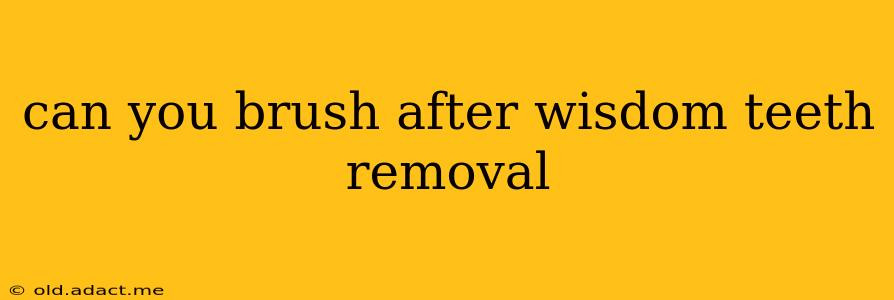Can You Brush After Wisdom Teeth Removal? A Comprehensive Guide
The question of when and how to brush after wisdom teeth removal is a common one, filled with understandable anxiety. The good news is that maintaining good oral hygiene is crucial for healing, but the process needs to be approached carefully. This guide will walk you through everything you need to know, addressing common concerns and providing expert-backed advice.
Understanding the Healing Process:
After wisdom teeth extraction, your mouth is a delicate ecosystem. Blood clots form in the extraction sites to prevent bleeding and promote healing. These clots are extremely vulnerable to dislodgement, which can lead to a painful and potentially serious complication called dry socket. Therefore, the immediate post-operative period requires a gentle approach to oral hygiene.
When Can I Start Brushing After Wisdom Teeth Removal?
This is perhaps the most frequently asked question. The answer isn't a single definitive timeframe, as it depends on the complexity of the surgery and your individual healing progress. However, a general guideline is to wait at least 24 hours after the procedure before attempting to brush. Even then, it must be done with extreme caution.
How Should I Brush After Wisdom Teeth Removal?
Gentle is the keyword here. Avoid the extraction sites entirely for the first few days. Focus on brushing the rest of your teeth with a soft-bristled toothbrush and a fluoride toothpaste. Use gentle, circular motions, avoiding any scrubbing or harsh pressure. Rinse gently with salt water (1/2 teaspoon salt dissolved in 8 ounces of warm water) several times a day to keep the area clean.
Specific Instructions:
- Day 1-3: Concentrate on cleaning the areas around the extraction sites with the soft-bristled brush. Avoid any direct contact with the sockets. Rinse with salt water frequently.
- Day 4-7: You can begin gently brushing around the extraction sites with a soft toothbrush. Use incredibly gentle circular motions. Be mindful of any discomfort.
- Day 7 onwards: As the healing progresses, you can gradually increase brushing near the extraction site, always maintaining a gentle approach.
What if I Have Bleeding or Swelling?
Bleeding and swelling are normal after wisdom teeth removal, but excessive bleeding or significant swelling should be reported to your dentist or oral surgeon immediately. Do not brush vigorously if bleeding occurs. Continue with gentle rinsing and contact your dental professional for guidance.
What Kind of Toothbrush Should I Use?
A soft-bristled toothbrush is essential. The gentler the bristles, the less likely you are to dislodge the blood clot or irritate the healing tissue. Consider an extra-soft toothbrush if you have sensitive gums.
Can I Use Mouthwash After Wisdom Teeth Removal?
Avoid alcohol-based mouthwashes for at least a week, as they can irritate the extraction sites. Salt water rinses are a much safer and more effective option in the early days of healing. After a week, you may consult your dentist or oral surgeon before using a prescription mouthwash if recommended.
When Can I Resume My Normal Brushing Routine?
Once your gums have completely healed (typically within 2-3 weeks), you can resume your regular brushing routine. However, always practice good oral hygiene to prevent future problems.
Conclusion:
Returning to a normal brushing routine after wisdom teeth removal is a gradual process. Patience and gentle care are key to a smooth recovery. Remember to follow your oral surgeon or dentist’s specific instructions, and don't hesitate to contact them if you have any concerns. Prioritizing good oral hygiene throughout the healing process will significantly contribute to a faster and more comfortable recovery.
